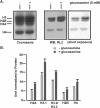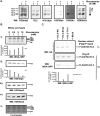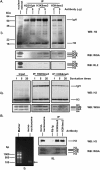Modification of histones by sugar β-N-acetylglucosamine (GlcNAc) occurs on multiple residues, including histone H3 serine 10, and is cell cycle-regulated
- PMID: 21896475
- PMCID: PMC3199494
- DOI: 10.1074/jbc.M111.284885
Modification of histones by sugar β-N-acetylglucosamine (GlcNAc) occurs on multiple residues, including histone H3 serine 10, and is cell cycle-regulated
Abstract
The monosaccharide, β-N-acetylglucosamine (GlcNAc), can be added to the hydroxyl group of either serines or threonines to generate an O-linked β-N-acetylglucosamine (O-GlcNAc) residue (Love, D. C., and Hanover, J. A. (2005) Sci. STKE 2005 312, 1-14; Hart, G. W., Housley, M. P., and Slawson, C. (2007) Nature 446, 1017-1022). This post-translational protein modification, termed O-GlcNAcylation, is reversible, analogous to phosphorylation, and has been implicated in many cellular processes. Here, we present evidence that in human cells all four core histones of the nucleosome are substrates for this glycosylation in the relative abundance H3, H4/H2B, and H2A. Increasing the intracellular level of UDP-GlcNAc, the nucleotide sugar donor substrate for O-GlcNAcylation enhanced histone O-GlcNAcylation and partially suppressed phosphorylation of histone H3 at serine 10 (H3S10ph). Expression of recombinant H3.3 harboring an S10A mutation abrogated histone H3 O-GlcNAcylation relative to its wild-type version, consistent with H3S10 being a site of histone O-GlcNAcylation (H3S10glc). Moreover, O-GlcNAcylated histones were lost from H3S10ph immunoprecipitates, whereas immunoprecipitation of either H3K4me3 or H3K9me3 (active or inactive histone marks, respectively) resulted in co-immunoprecipitation of O-GlcNAcylated histones. We also examined histone O-GlcNAcylation during cell cycle progression. Histone O-GlcNAcylation is high in G(1) cells, declines throughout the S phase, increases again during late S/early G(2), and persists through late G(2) and mitosis. Thus, O-GlcNAcylation is a novel histone post-translational modification regulating chromatin conformation during transcription and cell cycle progression.
Figures








Similar articles
-
β-N-Acetylglucosamine (O-GlcNAc) is a novel regulator of mitosis-specific phosphorylations on histone H3.J Biol Chem. 2012 Apr 6;287(15):12195-203. doi: 10.1074/jbc.M111.315804. Epub 2012 Feb 27. J Biol Chem. 2012. PMID: 22371497 Free PMC article.
-
Undetectable histone O-GlcNAcylation in mammalian cells.Epigenetics. 2015;10(8):677-91. doi: 10.1080/15592294.2015.1060387. Epigenetics. 2015. PMID: 26075789 Free PMC article.
-
Beta-N-acetylglucosamine (O-GlcNAc) is part of the histone code.Proc Natl Acad Sci U S A. 2010 Nov 16;107(46):19915-20. doi: 10.1073/pnas.1009023107. Epub 2010 Nov 2. Proc Natl Acad Sci U S A. 2010. PMID: 21045127 Free PMC article.
-
O-linked beta-N-acetylglucosamine (O-GlcNAc): Extensive crosstalk with phosphorylation to regulate signaling and transcription in response to nutrients and stress.Biochim Biophys Acta. 2010 Feb;1800(2):96-106. doi: 10.1016/j.bbagen.2009.07.018. Epub 2009 Aug 6. Biochim Biophys Acta. 2010. PMID: 19647786 Free PMC article. Review.
-
O-GlcNAcylation and oxidation of proteins: is signalling in the cardiovascular system becoming sweeter?Clin Sci (Lond). 2012 Oct;123(8):473-86. doi: 10.1042/CS20110638. Clin Sci (Lond). 2012. PMID: 22757958 Free PMC article. Review.
Cited by
-
Molecular Functions of Glycoconjugates in Autophagy.J Mol Biol. 2016 Aug 14;428(16):3305-3324. doi: 10.1016/j.jmb.2016.06.011. Epub 2016 Jun 23. J Mol Biol. 2016. PMID: 27345664 Free PMC article. Review.
-
Modulation of epigenetic targets for anticancer therapy: clinicopathological relevance, structural data and drug discovery perspectives.Curr Pharm Des. 2013;19(4):578-613. doi: 10.2174/138161213804581918. Curr Pharm Des. 2013. PMID: 23016851 Free PMC article. Review.
-
Characterization of the chromosome 4 genes that affect fluconazole-induced disomy formation in Cryptococcus neoformans.PLoS One. 2012;7(3):e33022. doi: 10.1371/journal.pone.0033022. Epub 2012 Mar 7. PLoS One. 2012. PMID: 22412978 Free PMC article.
-
Epimutations and Their Effect on Chromatin Organization: Exciting Avenues for Cancer Treatment.Cancers (Basel). 2022 Dec 29;15(1):215. doi: 10.3390/cancers15010215. Cancers (Basel). 2022. PMID: 36612210 Free PMC article. Review.
-
Tumor Necrosis Factor (TNF) Receptor Expression Determines Keratinocyte Fate upon Stimulation with TNF-Like Weak Inducer of Apoptosis.Mediators Inflamm. 2019 Dec 5;2019:2945083. doi: 10.1155/2019/2945083. eCollection 2019. Mediators Inflamm. 2019. PMID: 31885495 Free PMC article.
References
-
- Love D. C., Hanover J. A. (2005) Sci. STKE 2005, re13 - PubMed
-
- Hart G. W., Housley M. P., Slawson C. (2007) Nature 446, 1017–1022 - PubMed
-
- Zachara N. E., Hart G. W. (2004) Trends Cell Biol. 14, 218–221 - PubMed
-
- Hurtado-Guerrero R., Dorfmueller H. C., van Aalten D. M. (2008) Curr. Opin. Struct. Biol. 18, 551–557 - PubMed
Publication types
MeSH terms
Substances
LinkOut - more resources
Full Text Sources
Other Literature Sources
Molecular Biology Databases

